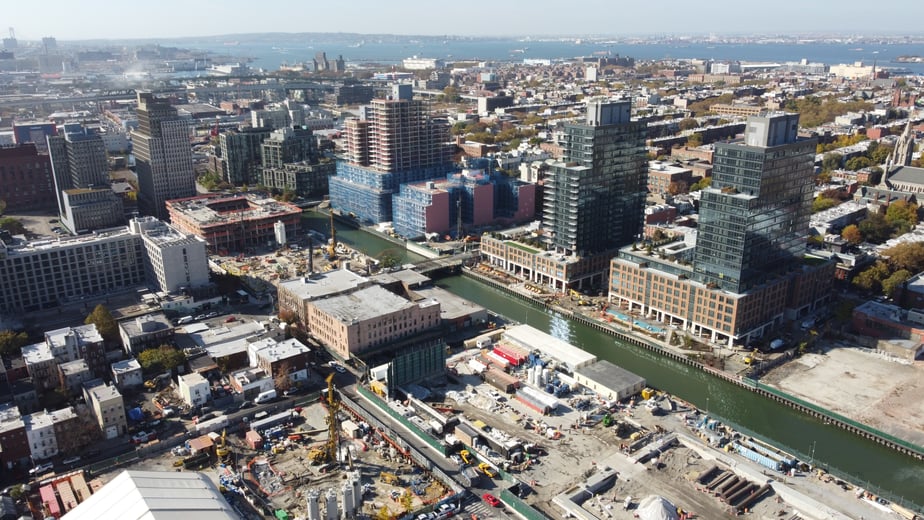Why the Gowanus Rezoning Matters: Risk, Lending, and Retail Storefront Opportunities

Introduction: Why Gowanus Matters Now
Gowanus is no longer the overlooked industrial corridor of Brooklyn. Following its historic rezoning in 2021, the neighborhood is experiencing one of New York City’s largest transformation projects. With 8,000+ housing units planned and over 650,000 square feet of commercial, retail, and storefront space in the pipeline — including more than 100,000 SF of designated “Gowanus Mix” maker space — Gowanus represents both enormous opportunity and measurable risk for developers, lenders, and retail tenants.The 2021 Rezoning: How It Passed
The Gowanus Neighborhood Plan was approved by City Council on November 10, 2021, after years of environmental reviews and community debate. The rezoning:
- Opened industrial land to mixed-use development including retail and storefront uses.
- Created opportunities for new neighborhood-serving storefront tenants.
- Mandated inclusion of “Gowanus Mix” space — retail, maker, and commercial uses critical for a diverse tenant base.
This was not just a zoning change — it was a policy statement about how Brooklyn integrates housing, retail, and storefront vitality.
Why the Rezoning is Critical for Commercial Property & Lending
Commercial Demand & Flexibility
Developers can build more FAR if they include commercial or maker uses, which strengthens income diversification and boosts long-term resilience.
Environmental & Infrastructure Risk
With the canal’s history of contamination, lenders and investors weigh cleanup obligations, flood protections, and regulatory requirements heavily in underwriting.
Affordable Housing Mandates
Financing often requires layering incentives like LIHTC, 421-a replacements, and tax exemptions — making deal structuring complex.
Absorption Concerns
With thousands of new apartments coming online, absorption rates will determine how sustainable the market is. Retail and commercial tenants will follow foot traffic, but timing is critical.
Market Benchmarking
How capital views risk in Gowanus will influence how similar rezonings are financed citywide.
Key Types of Uses Filling Gowanus Storefront & Second-Floor Space
One of the most important shifts created by the rezoning is how space can be programmed and absorbed. Beyond traditional storefront retail, developers are actively exploring and signing tenants in categories such as:
- Neighborhood Retail & Markets – Supermarkets, specialty food, and neighborhood-serving storefront tenants.
- Daycares & Early Childhood Centers – Demand is high in mixed-use neighborhoods, especially in family-friendly residential towers.
- Health & Wellness Operators – Fitness studios, urgent care, and wellness brands anchor retail corridors in rezoned neighborhoods.
- Co-Working & Creative Studios – Second-floor spaces are ideal for flexible workspaces, similar to The Shop co-working model already proven in Gowanus.
- Experiential Uses – From gallery/showroom hybrid spaces to entertainment concepts, these uses help diversify income streams and drive traffic.
The rezoning’s inclusion of Gowanus Mix ensures that many of these spaces are not optional but required, guaranteeing a vibrant blend of retail, community facility, and creative commercial uses.
Major Gowanus Projects with Retail & Storefront Components
420 Carroll Street
- ~360 apartments and 27,000 SF of ground-floor retail storefronts.
- Early leasing success confirms demand for neighborhood-serving tenants.
175 Third Street – Gowanus Wharf (Charney & Tavros)
- 1 million SF of mixed-use space with a significant portion dedicated to commercial and retail storefront tenants.
- Critical test case for absorption of both housing and storefront retail.
Society Brooklyn (500 Degraw & 504 Sackett)
- Two 21-story towers with street-level retail storefronts.
- Highlights how residential density creates demand for ground-floor retail.
Retail Absorption & Storefront Leasing Trends in
- Over 650,000 SF of commercial and retail space under development.
- More than 100,000 SF of “Gowanus Mix” storefront space designed for creative, maker, and retail tenants.
- Early lease signings at 420 Carroll Street show demand from grocers, specialty food, and boutique storefront tenants.
- Second-floor space is drawing interest from daycares, co-working operators, and showrooms that thrive outside of prime ground-floor retail.
- Future absorption at Gowanus Wharf will be the ultimate indicator of market depth.
REBNY Brooklyn Commercial Committee Event – Sept 30
Join me, Nate Mallon, and my co-chair Fritz Richter for a REBNY Brooklyn Commercial Committee event focused on Gowanus storefront and retail opportunities:
- 395 Carroll Street
- Tuesday, September 30, 3:30 PM
Agenda:
- Steven Jemal, S3 Capital Partners – “Identifying Risk in a Newly Rezoned Area”
- Walking tour of Gowanus retail and storefront pipeline
- Happy Hour sponsored by Verada and Avison Young
Conclusion: The Future of Retail and Storefronts in Gowanus
The Gowanus rezoning is more than a housing story — it’s a retail and storefront story. With thousands of new residents arriving, ground-floor storefronts and second-floor creative uses will define the neighborhood’s culture and economy. Developers, lenders, and tenants alike are watching closely as leasing unfolds.

The Gowanus Canal framed by residential towers and future retail storefronts, highlighting the scale of Brooklyn’s rezoning.

Active construction zones in Gowanus where new storefront retail, maker space, and commercial projects are taking shape.

Redevelopment along the Gowanus corridor — rezoning is bringing housing, retail storefronts, and community facilities to Brooklyn.
You might also like...
REBNY Brooklyn Commercial Committee Hosts Gowanus Walking Tour & Happy Hour at 395 Carroll Street
Event Recap On September 30, the REBNY Brooklyn Commercial Committee hosted a walking tour and happy hour at 395 Carroll Street in Gowanus. This was ...
Wellness as an Anchor: Health-Focused Tenants Fuel Brooklyn’s Leasing Growth
Introduction Across Brooklyn, wellness isn’t just a lifestyle—it’s reshaping the retail market. From boutique med-spas and recovery lounges to hybrid ...

